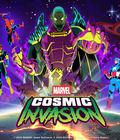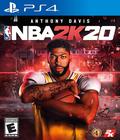Buy NBA 2K20
Twenty years ago, the NBA 2K series launched on the Sega Dreamcast, and the title received high praise from critics and fans alike. The series has maintained a high level of polish, but in the meantime, the competing series by EA and Sony have struggled, leaving NBA 2K20 as the year's lone basketball simulation. That might make its purchase a no-brainer for fans, but recent iterations have shown that there's still plenty of work to add a level of polish to the games, and that also applies to this year's version.
First comes the good news. As with every year since its inception, the gameplay in NBA 2K20 is unrivaled. Dribbling alone has over 20 different variations, while the overall momentum during movement feels natural. Passes don't look magnetic, and shooting looks like it would during NBA broadcasts. Everyone looks and acts as expected on the court, except for a few boneheaded moves, like fouling unnecessarily or making bad passes, but such things are rare.
There's a bit of contention around the new badge system, which acts like power-ups in that they designate abilities for expected players. For example, Steph Curry has a badge that makes him a lethal shot behind the arc, while Anthony Davis has a badge for quickly regrouping after getting blocked. It explains why certain players can do certain things, but the reception is mixed among fans.
If you've been away from the series for a while, you'll find that all of this freedom for abilities and movement comes at the cost of controls. To be fair, it's generous that the game has options for both analog stick movements and button presses for some of the basics, but the precise timing needed for good shots means that your initial games will be blowouts and not in your favor. Luckily, the game supplies a generous tutorial and practice modes that help you understand your controller, so you can mimic what's being taught. As long as you don't expect to become an expert in a few minutes, the practice can be enough for you to beat average CPU opponents with a decent final score.
Another new thing this year is the inclusion of the WNBA, a first for the series and a response to NBA Live's inclusion of the league. Much as in the men's game, you have all of the teams in the WNBA, and their rosters are constantly being updated during the season. If you're jumping between this and the regular NBA games, you'll notice how the same level of polish is applied to both leagues and how spacing becomes a more important feature here. Not all of the players here look like their real-life counterparts, however, and the real coaches are completely absent. The addition of a new set of commentators is nice, but they don't gel as well as the regular crew.
The inclusion of the WNBA means that the game's wealth of offline modes runs deeper than before. Quick games can involve teams from the current NBA, WNBA (though not against the NBA teams), and all-stars from different eras (e.g., the '96 Bulls) and individual teams. You can select a team of the very best players to ever put on the Spurs uniform and see how they can hang with the current Warriors team. Blacktop games are also available, and you can go for standard 5v5, 1v1, and any combination in between. There's a season mode for both the NBA and WNBA, along with a playoff mode, but that's only for the NBA.
Aside from the lack of WNBA presence in the other solo modes, there are other areas that are heavily flawed. MyLeague still features the chance to play in online and offline leagues for up to 80 years, but it hasn't received any updates since last year's version. Meanwhile, MyGM seems to be possibly more restrictive than before due to the removal of a few features in favor of a leaderboard. For something that's dedicated to offline play, it seems rather wasteful to have a global leaderboard.
If the offline experience is all you care about, then NBA 2K20 would be an almost-instant purchase despite some of its missteps. However, significant issues pop up in the online play. Like clockwork, the game's launch was a disaster, with a bevy of disconnects and severe bouts of lag due to the servers practically buckling under the pressure. It's disappointing since the development team should know about the game's high demand by now. It has improved, but you'll still hear about games getting disconnected or lag hitting at the right time to make you commit fouls or whiff on a shot.
The other two modes are considered by 2K as the biggest pieces of the game. MyCareer mode is split into two distinct portions. The first is the story mode, which was produced this year by LeBron James and his Springhill Productions studio. Titled "When the Lights Shine Brightest," it tells the story of your created character Che, a college senior who sees his draft standing drop when he speaks out against something that he feels is wrong. From here, his NBA journey takes him through other tournaments and the minors, while seeing if he can balance a life outside of basketball to build his brand.
Although this portion is mostly a tutorial, it also works as a story. This is a typical tale of a kid trying to make his dreams come true by going pro, but it balances well with the current climate and having people take a stand for their beliefs. This isn't exactly the most well-told story, though. There are some excellent performances by Rosario Dawson and Idris Elba, and others like Ernie Hudson make a cameo or two, and those work fine. Other cameos, mostly of the athletes, sound stiff and predictable, so the impact is groan-worthy instead of inspiring. It is better than some of the stories that have preceded it, such as one game where someone was named Frequency Vibrations, or another title that featured a professional DJ who won a basketball tournament and was easily accepted into the league.
After four hours or so, you'll make it out of the story and into the more open-ended part that is The Neighborhood, and as before, you'll either love it or hate it. You're still in the same large area where you can see other people playing pick-up games, and you can join in if you wish. If you need to make character upgrades or clothing changes, you'll need to run to the appropriate shop to get that done instead of going through a menu. On the one hand, it's kind of cool to see an NBA-themed Second Life. On the other hand, with the load times between stores and the multitude of people you have to wade through, it can be a chore if you change out lots of things before your next game.
That leads to the thorny issue of VC. Compared to past years, things have gotten a little better, since you don't have to pay for things like haircuts. The grind to get VC is also lessened, so reaching acceptable levels for your player doesn't have to be a second full-time job. The grind is still present, as the prices for player aesthetics, badges and moves are still quite pricey. Leveling up your guy is also pricey, even if the costs aren't as high as before. You aren't earning that much more in your games, win or lose. Even if you went ahead and splurged on the premium editions of the title, the extra VC isn't enough to get you to a more competitive level right out of the gate. Thus, reaching an acceptable level means that the grind is like a second part-time job, so it isn't as back-breaking, but it still sucks that we're being pressured to spend more money on a full-priced game so we don't lose too badly online.
It also doesn't help that NBA 2K20 has a complete gambling area to earn VC and other currency forms for the other major mode, MyTeam, which sees you crafting your team out of trading cards and spending those currency forms to obtain new packs or win auctions for specific cards. Considering that there's an actual cash prize for players who do well online with their constructed team, there's a big drive to spend that money on a lottery for some good cards. With that said, it feels rather gross and tone-deaf to see minigames, slot machines, spinning wheels, and tickers, especially when other games are catching heat for loot boxes and gambling on a smaller scale.
Outside of the inherent thrill of being lucky or rich enough to construct the best time, one thing that makes MyTeam bearable is the fact that the mode now has offline challenges. It's helpful for those who want to check things out but not get thrashed online, and you earn VC from doing so. However, the gain is low enough that you're still encouraged to go online instead, which means spending to get at least halfway decent.
Your opinion of NBA 2K20 will be wholly dependent on your primary focus for the game. If you're looking for offline local play, the title is still the best there is at simulation basketball. Even with a control scheme that's initially difficult to grasp, it feels right in every aspect that counts. It also helps that the game is stacked with modes to keep you busy way before you'll start to crave NBA 2K21. If you're going for online play with just NBA teams, then prepare for the same issues as before, with random disconnects and bad lag unless you get lucky. If you're trying to go for the addictive MyTeam or MyCareer beyond the campaign, expect to slog through everything unless you break down and pay for the VC to take care of it all. Overall, NBA 2K20 is still one of the best basketball games out there, but future iterations should either ease up greatly on the VC spend or drop the price significantly, so players won't have to spend extra money.
Score: 7.0/10
More articles about NBA 2K20










 NBA 2K20 continues the franchise's tradition as the gold standard of basketball simulation across all platforms with unrivaled realism and true NBA gameplay.
NBA 2K20 continues the franchise's tradition as the gold standard of basketball simulation across all platforms with unrivaled realism and true NBA gameplay.





